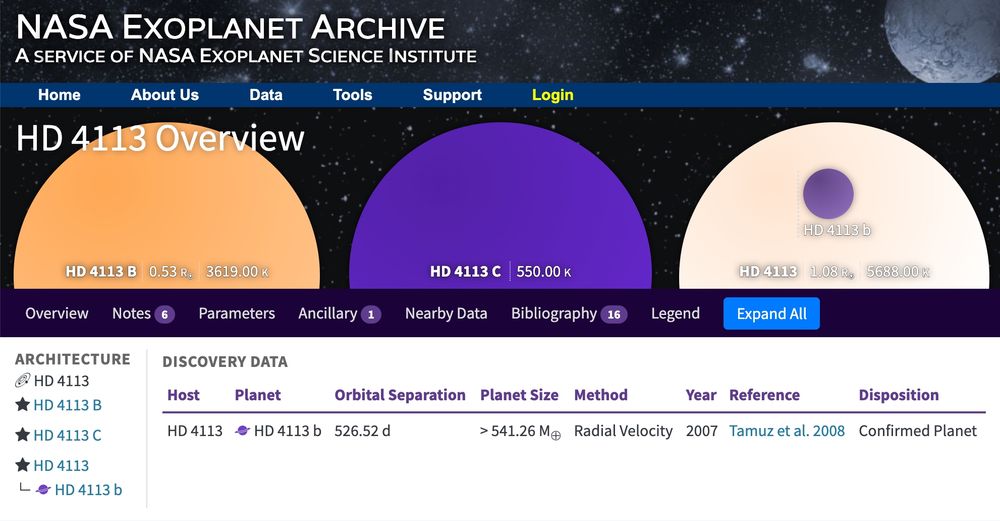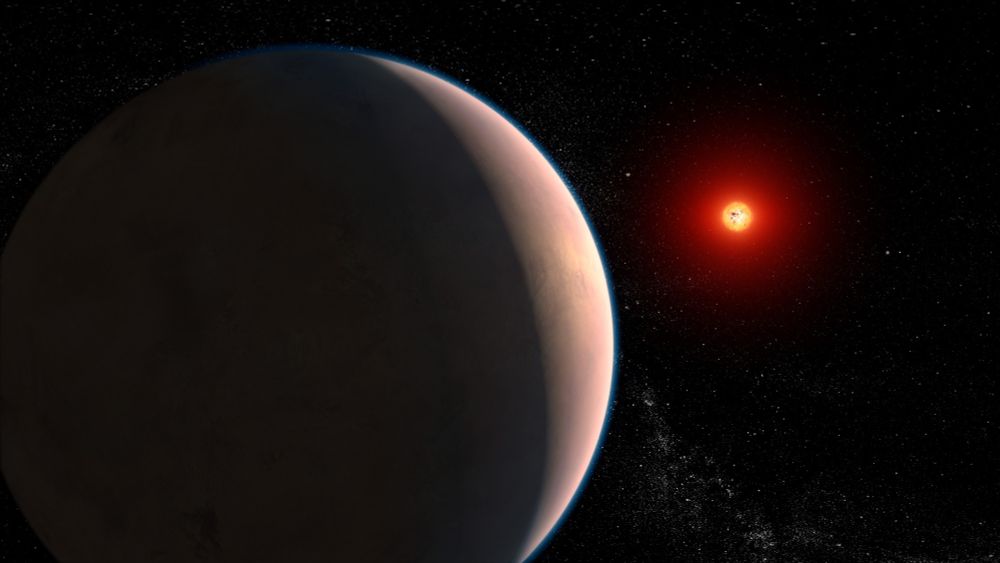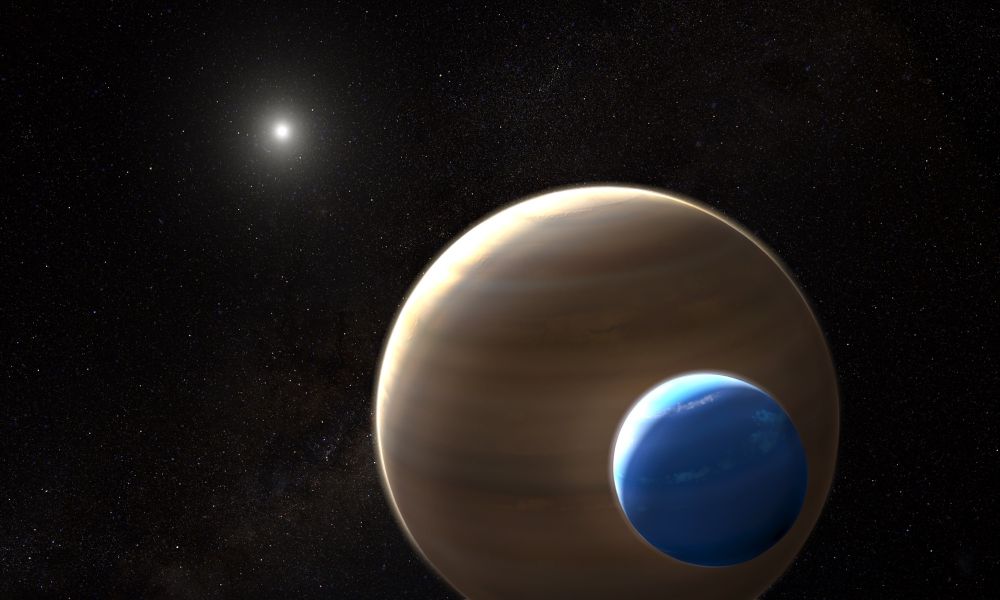The average SNAP benefit per month is $177 a person.
The average ACA benefit per month is up to $550 a person.
People want us to hold the line for a reason. This is not a matter of appealing to a base. It’s about people’s lives.
And working people want leaders whose word means something to them.
10.11.2025 01:49 — 👍 62211 🔁 15122 💬 2080 📌 637

Screenshot of the NASA Exoplanet Archive overview page for HD 4113, a triple star system with three differently coloured stars (one of which has a planet, HD 4113 b).
Hey you. YES YOU. Super persnickety astronomer. You know who you are.
NASA Exoplanet Archive just updated our overview pages so the stars are closer to their actual colours, as per Harre & Heller (2021) and Cranmer (2021).
You're welcome. 😎
(You can thank @kevinkhu.bsky.social!)
08.11.2025 00:25 — 👍 76 🔁 9 💬 4 📌 2

WOMEN IN PHYSICS DAY!
In honor of the pioneering women in physics who broke down barriers to do what they love, we celebrate Women in Physics Day on November 7th, the birthdate of both Marie Curie and Lise Meitner.
Marie Skrodowska-Curie (1867-1934)
Radioactivity pioneer, two-time Nobel laureate
A giant of science, Marie Sktodowska-Curie conducted pioneering research on radioactivity, a term she coined. She discovered two elements, founded two medical research centres, won two Nobels, and invented mobile X-ray units (dubbed petites Curies), saving countless lives in World War
Lise Meitner (1878-1968) Nuclear physicist
When Lise Meitner was a teen, Austria restricted female higher education. She pursued physics anyway, and 25 years later became the first woman in Germany to hold a professorship in physics. She helped discover nuclear fission, but was contentiously not awarded the 1944 Nobel alongside collaborator Otto Hahn.
NOVEMBER 7TH
Dear Physicists and Physics fans,
I would like to encourage you to celebrate #WomenInPhysics Day this Friday, November 7th.
Why November 7th? Because it is the birthday of two of the most impactful women physicists of the 1900's: Marie Curie and Lise Meitner. 🎢 ⚛️ 🧪 👩🔬
03.11.2025 17:02 — 👍 295 🔁 153 💬 2 📌 6
AAS 247: Workshops | American Astronomical Society
Already registered for #AAS247, but didn’t sign up for any workshops? Here’s how to sign up:
aas.org/meetings/aas...
1) Click “Register for AAS 247” from the conference webpage
2) Scroll to the table with the section labeled “1. Workshops”
3) Scroll to the workshop you want , click “Add”
(1/2)
04.11.2025 16:36 — 👍 2 🔁 1 💬 1 📌 0

HiRISE 3D: Fine Layer Deformation Redux
Today’s HiPOD doubles as our 3D post because it was just too good to pass up! (See the HiPOD for details.)
Full image: https://www.uahirise.org/anaglyph/ESP_089275_2270_ESP_088932_2270_RED
NASA/JPL-Caltech/University of Arizona
#Mars #NASA #science
28.10.2025 17:00 — 👍 27 🔁 6 💬 0 📌 0

Comet Lemmon stretches across the sky over a dimly lit mountain ridge. The comet is relatively faint, but its teal core is easily visible, and its tail extends quite a ways up into the corner of the image.
Making Lemmonade 🍋
Couldn’t pass up a chance to go after Comet Lemmon given last night’s combination of clear skies and a new moon. Good way to replenish the soul after that heartbreaking ALCS finale. 😅
🏷️: 📸🌿🐡🔭
22.10.2025 21:41 — 👍 82 🔁 13 💬 2 📌 0
For this money, your tax dollars could have paid for a second TESS mission to find planets, but instead:
18.10.2025 18:53 — 👍 39 🔁 10 💬 0 📌 0
So proud of Phoenix! She’s amazing, does cool research and has done so much at an early stage in her career. She’s applying to grad programs too! So 👀. Y’all would be lucky to have her! #BlackInAstro
16.10.2025 20:53 — 👍 27 🔁 4 💬 0 📌 0

Joseph Barranco posted on social media: Go Bears! Nobel Prize in Physics goes to 3 physicists studying mesoscopic quantum phenomena... Work was done in the 1980s in UC Berkeley Professor John Clarke's lab with his graduate student John Martinis and postdoctoral fellow Michel Devoret... all 3 share the Nobel Prize. Must also point out that both Clarke and Devoret are immigrants from the UK and France, respectively. All 3 are pioneers in the race to build the most powerful quantum supercomputers. California *public* education made this happen. Immigration made this happen.
Valuable info about the Physics Nobel Prize today from Prof. Joseph Barranco at SFSU on Martinis and Devoret being a grad student and postdoc in Clarke's lab at UC Berkeley & Clark and Devoret being immigrants. "California *public* education made this happen. Immigration made this happen." ⚛️
07.10.2025 17:53 — 👍 397 🔁 130 💬 2 📌 8

These alien planets are astronomers’ favourites: here’s why
Space scientists look back on 30 years of exoplanet discoveries — from rows of massive ‘super-Earths‘ to worlds with perfectly synchronized orbits.
This week (!) is the 30th anniversary of the announcement of 51 Pegasi b, the first exoplanet found orbiting a star like our Sun - since then, we've found over 6,000!
To celebrate, @alexwitze.bsky.social and @nature.com collected some astronomers' favourite planets:
www.nature.com/articles/d41...
02.10.2025 20:55 — 👍 201 🔁 53 💬 5 📌 11
Outstanding new paper from Evert Nasedkin on the variable, isolated exoplanet analog, T dwarf, SIMP-0136! Time resolved atmospheric retrievals find temperature driving variability and potential auroral signatures (stratospheric temperature inversion)!
26.09.2025 12:36 — 👍 5 🔁 1 💬 0 📌 0

An illustration of a young planet with a surrounding disk of dust and gas potentially forming moons. The planet, which appears dark red, is shown at lower right, circled by a cloudy, clumpy reddish orange-colored disk. The host star appears at upper left, and glows yellow, with its own reddish disk of debris. The disk that surrounds the planet takes up about half the illustration. The black background of space is speckled with stars. At the bottom of the illustration, graphics of molecules are listed in the following order: Acetylene, Carbon Dioxide, Ethane, Benzene, Hydrogen cyanide. The words Artist’s Concept appear at upper right.
#NASAWebb has found the first direct evidence of potential moon formation around a giant exoplanet. The discovery is shedding light on how such systems evolve and why moons could be potentially habitable worlds: https://bit.ly/46xGodN 🔭 🧪
29.09.2025 14:03 — 👍 87 🔁 31 💬 1 📌 9
I was at The Ohio State University!
28.09.2025 19:18 — 👍 1 🔁 0 💬 2 📌 0

Astro-color alchemists
Astronomers have a method for colorizing grayscale images from various space- and groundbased observatories.
STScI's Alyssa Pagan says that there is a methodology for dealing with the wider electromagnetic spectrum: “In terms of assigning color, we generally do some standard chromatic ordering because it has the most scientific value and meaning in it, and usually also gives you aesthetic images.” 🔭 🧪
26.09.2025 17:59 — 👍 91 🔁 23 💬 0 📌 1
For those who may not know ... the magnetic field of Uranus is tilted ~60 deg relative to its spin axis.
So it looks like the aurorae are occurring near the equator, because, in fact, they are! Within ~ 30deg of the equator.
25.09.2025 16:15 — 👍 92 🔁 21 💬 2 📌 0
Congratulations!!
24.09.2025 16:38 — 👍 2 🔁 0 💬 0 📌 0
We *absolutely* should celebrate it. Do your part by enjoying the 200+ page masterpiece in its entirety on ADS! ui.adsabs.harvard.edu/abs/1925PhDT... 🔭
Special shoutout to Figure 2, an incredible piece of art that I want on my wall (and suspect could even make an excellent tattoo if executed well?)
23.09.2025 20:03 — 👍 43 🔁 20 💬 4 📌 0

Today is a special paper day for me: for the first time we can do chemistry in a circumplanetary disk around a planetary-mass companion! Gabriele Cugno and I used JWST to tease out the signal of CT Cha b, finding a rich carbon chemistry (7 molecules + 1 isotopolog detected)! arxiv.org/abs/2509.15209
19.09.2025 15:22 — 👍 37 🔁 4 💬 5 📌 2
Some tidbits about the most recent 1,000 exoplanets:
- Nearly half (~490) were discovered with NASA's TESS mission
- As a result, their host stars are nearly *10 times brighter on average* than previous stars!
- We have found a lot more cool giant planets (Jupiter analogs), with RV and imaging
17.09.2025 18:39 — 👍 56 🔁 10 💬 3 📌 1

A close-up photo of a box of cupcakes with gold candles spelling out ‘6000’.

A group of smiling people - scientists, engineers, data analysts and writers - standing behind a table of goodies.
Sometimes 2025 just feels like a lot, and you need an excuse to celebrate your fabulous team (and the whole exoplanet community!) reaching a new milestone…
Happy 6,000 Confirmed Exoplanets Day, everybody!!!!
(You may recognize the narrator of the video at the link! 🫣)
www.nasa.gov/universe/exo...
17.09.2025 18:22 — 👍 244 🔁 58 💬 11 📌 10

Screenshot of research.gov after logging in, showing link for "Prepare and Submit Proposals" on the left in a red oval.

Screenshot of "Prepare New Full Proposal" on research.gov, with "add a new role" and "NSF 22-621" circled in red. In order to see the listing of the NSF Astronomy and Astrophysics Postdoctoral Fellowship, one must change role to "Proposed Postdoctoral Fellow"!
NSF Astronomy & Astrophysics Postdoc Fellowship apps are OPEN! 🔭 However, app only appears on research.gov if your role "Proposed Postdoctoral Fellow"! Click "Proposals", "Prepare and Submit Proposals", then "Prepare New". If you do not see NSF 22-621, change role to "Proposed Postdoctoral Fellow"!
11.09.2025 17:53 — 👍 43 🔁 32 💬 0 📌 0

A rocky planet in its star’s ‘habitable zone’ could be the first known to have an atmosphere – here’s what we found
The largest telescope in space has been trained on a rocky exoplanet.
We observed the habitable zone planet TRAPPIST-1e with JWST to search for an atmosphere.
You've seen the headlines, now let's dive into the science! 🧪
THREAD (1/N)
#Exoplanets 🔭
09.09.2025 23:13 — 👍 217 🔁 67 💬 5 📌 7
Okay, now that I can stop talking with all caps, why is this important?
So, we're looking for planets like Earth, right? It's the only place we've found with life so far.
What makes it "Earth"? Well, some things include being a rocky planet, and being the right temperature for liquid water. (1/N)
08.09.2025 20:32 — 👍 134 🔁 42 💬 4 📌 5

Screenshot of the NASA Exoplanet Archive homepage for the alpha Cen system.
WELCOME TO THE FAMILY, ALPHA CEN A b!!!
First hinted at in Wagner+21, now Chas Beichman, Aniket Sanghi and team have published new JWST images of alpha Cen A showing another hint of this Saturn-sized planet candidate!
exoplanetarchive.ipac.caltech.edu/overview/alp...
07.08.2025 17:25 — 👍 104 🔁 18 💬 0 📌 1

What’s Going On Inside GJ 486b?
Astrobites reports on a warm, rocky exoplanet and what might be hidden beneath its atmosphere.
Kaz Gary reports for @astrobites.bsky.social on a warm, rocky exoplanet and what might be hidden beneath its atmosphere. aasnova.org/2025/08/05/w... 🔭
05.08.2025 16:08 — 👍 29 🔁 7 💬 3 📌 0

Image from 2025 summer graduation at Ohio State with 5 people in PhD regalia in front of empty seats and a stage with the OSU seal. L to R: Laura Lopez, Joy Bhattacharyya, Caprice Phillips, Alison Duck, Scott Gaudi.
Honored to celebrate 3 new astro doctors yesterday @joybee8.bsky.social, @capricephillips.bsky.social, @astroalison.bsky.social with @scottgaudi.bsky.social! Thanks to @jajohnson.bsky.social for lending me UC Santa Cruz regalia & to the OSU French & Italian prof who fixed my own backwards hood. 😂
05.08.2025 03:03 — 👍 69 🔁 6 💬 3 📌 1
Team Lead Research & Development, PLATO Mission of ESA 🚀, Max Planck Institute for Solar System Research | Lecturer for astrophysics, University of Göttingen
Astrophysicist & associate prof at the University of Colorado Boulder. I study the hot, expanding outer atmospheres of the Sun & other stars. Other weird stuff (infinite math? sci-fi? Tolkien? Harlan Ellison? Hesse's Glass Bead Game?) may show up here, too
University physics lecturer and Associate Dean, Learning. Physics demystifier. Supporter of girls and women in physics. CAP Teaching Medal 2018, 3MNTF 2023. She/her Ph.D.
Waitress turned Congresswoman for the Bronx and Queens. Grassroots elected, small-dollar supported. A better world is possible.
ocasiocortez.com
Mayor-Elect of New York City
NancyRomanSci is managed by the Roman Science Centers and provides researchers with the most up-to-date information related to doing science with NASA's Nancy Grace Roman Space Telescope
I have friends everywhere
writer/editor open to work + writing a book
member @transjournalists.org
linktr.ee/leximcmenamin
Astronomer, software engineer. Supporting space telescopes, open science, and accessibility in astrophysics.
Thrilled and haunted by dots on stars.
http://brettmorr.is/
Posts my own, not my employer's.
Astronomer working on imaging extrasolar planets, instrumentation, and science policy. Spare time involves hiking with a golden retriever, and not playing enough boardgames.
Director, University of California Observatories, but opinions are my own. He/him
Theoretical Astro/Physicist:
https://chanda.science
First book:
https://tinyurl.com/DisorderedCosmos
PREORDER MY NEXT BOOK:
https://tinyurl.com/EdgeOfSpaceTime
Newsletter:
news.chanda.science
all Black/all Jewish. 🏳️🌈/agender/woman.
Posts by/for me🖖🏽
Associate Astronomer at the University of Arizona. JWST/MIRI Instrument Team. Debris disk aficionado. Classic car enthusiast. Opinions my own. He/him
Author of bestselling memoir,
SOMEBODY’S DAUGHTER.
Women & Girls Reporter for Free Press Indiana.
I deserve it all.
https://linktr.ee/SmashFizzle
narrative director at Firaxis. emergent/systemic storytelling. nominated for awards and things. lit PhD. awful at Greek. better profile coming soon.
they/them | aroace | cmu (astro)physics | monstera lover | trying to romanticize my life a little
Physics Reporter at New Scientist. Author of ENTANGLED STATES, forthcoming from Beacon Press in May 2026. Former teacher. Vegan baker. Aspiring gym rat. Croatian in Queens. Queer.
she/her. (Exo)planetary clouds/hazes. Sagan Fellow at NASA GSFC/STScI --> Asst. Prof of Astro at UMD starting Fall 2026.
Opinions all me and only me.
Still screaming inside my heart.
https://tx.ag/moran
Orbit in style with science socks, space jewelry, and beyond. Stellar gifts for scientists, engineers, and astronomy lovers.
ScienceSocks.co
Which mineral is the best of them all? Campaign & vote in #MinCup each September. #OreCup starts November 3, 2025! www.MineralCup.org
Kyanite photo credits: Smithsonian Institution
Never Bullshit
I challenge any and every one who wants to kick my ass to a debate .
https://www.patreon.com/dril
https://www.instagram.com/dril
https://linktr.ee/drilreal



















